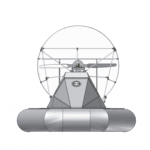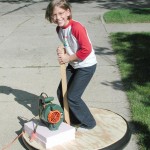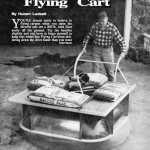DIY Hovercraft Plans – Leafblowers, Lawnmowers, 4 Stroke Engines
 No one can argue that the hovercraft isn’t the coolest vehicle ever. And no one will argue that building one is a great idea. Turns out that they’re not too complicated to assemble, and depending on the size you want you may have the materials in your garage right now.
No one can argue that the hovercraft isn’t the coolest vehicle ever. And no one will argue that building one is a great idea. Turns out that they’re not too complicated to assemble, and depending on the size you want you may have the materials in your garage right now.
All hovercraft use the same concept: A blower attached to a skirted platform creates lift. The amount of lift depends on the size of the blower, the strength of the platform, and the depth of the skirting. The air that pushes out underneath the skirting creates a nearly frictionless surface for the vehicle to move on.
Want one? Make it!
 Simple version: The leafblower hovercraft.
Simple version: The leafblower hovercraft.
 Platform: small piece of plywood
Platform: small piece of plywood
Skirt: 6mil plastic
Blower: a leaf blower from the toolshed
Details: The plastic skirting is affixed to the edge of the platform and continues entirely underneath it ( use duct tape and staples to get a good connection – and leave a bit of slack).
-A grommet (plastic coffee can lid) is placed in the center of the plastic on the bottom and screwed through it to the platform, to create a donut effect when the bag inflates.
-A small series of holes are cut in the skirt just past the grommet to let the air escape. -Air from the leaf blower inflates the skirt, and pushes out the holes underneath, creating a film of air that is nearly frictionless.
A single leaf blower can levitate a grown human this way.
Locomotion and steering: Your friend pushes you from behind. And laughs as you uncontrollably slide down a steep driveway.
Here’s a version on Instructables, one from Make magazine (PDF), and one person’s hovercraft projects.
Plus, a video:
 More advanced version: Vintage chainsaw engine hovercart.
More advanced version: Vintage chainsaw engine hovercart.
 Platform: Custom built wooden and metal framework that incorporates plastic skirting
Platform: Custom built wooden and metal framework that incorporates plastic skirting
Skirt: 6mil polyurethane plastic sheeting
Blower: Chainsaw engine connected to propellor assembly
Details: A vintage project from Popular Science, July 1960. The designer set out to make a hovercraft but found that his project worked better as a frictionless wheelbarrow. The high center of gravity and heavyweight platform almost certainly a problem, this would work well as the basis for modifications to make a higher capacity and more controllable version.
What’s funny is that this one was advertised to carry 200lbs of weight – which is about the same as the leafblower version above. But it has more clearance, and with those modifications, it can be much more useful.
Locomotion: You, pushing it like a rototiller. Modify it to add a fan on the back for steering.
This is posted on Vintage Projects. Download the PDF instructions here.
 Badass version: HoverWorks EasyRideAir hovercraft kit
Badass version: HoverWorks EasyRideAir hovercraft kit
Platform: Highly designed, buoyant hull. Precut wood comes ready to assemble.
Blower and Locomotion: 4 stroke 26hp Briggs and Stratton v twin engine, mated to a variable pitch, forward/reverse propellor that allows the hovercraft to brake and move backwards. Lift provided by an axial multiwing lift fan.
Details: Only somewhat a “DIY” hovercraft, this New Zealand-made kit comes with all the pieces to make a seriously kick-ass hovercraft for racing around the polo fields or across whatever lake might be in your way. It won’t be cheap though! Shipping alone is a few hundred bucks to Canada, and I’m not even sure if that’s NZ or Canadian dollars.
Take inspiration from this and make your own… like this guy’s awesome vehicle:
Russian hovercraft project using a small lawnmower engine:
You can also get tiny RC hovercraft that are fun for desktop racing, and apparently work in water if you tape over the battery contacts and gaps on the bottom – but don’t yell at me if you break yours. This is a lil bigger than a matchbox car.
